Practice Insights > Lessons From Practice > Development
Management of Commons: Lessons from Foundation for Ecological Security
By: V Santhakumar, Subrat Mishra, Anant Gangola
1. Introduction
Forests, water resources, grazing lands are called common property resources or commons. These resources meet the direct needs of human beings, such as the water for domestic and agricultural purposes, fuelwood, fodder for cattle, and in the form of several non-timber forest products. Commons also serve important ecological functions, like the sustenance of biodiversity, soil and water conservation, etc. There is a need to protect these commons, and that may require informed collective action on the part of the users.
There are certain situations (we discuss these in detail in the following sections) in which such sustained collective action may not be carried out by the users alone. It may require external intervention. Non-governmental organizations have played an important role in this regard. We look at the work of one such organization, namely, Foundation for Ecological Security (FES), in this report. This is based on a short-period field-work in two locations – one in Bagepalli block in Karnataka state and another in Thambalapalle block in Andhra Pradesh. The focus is on the management of water resources in the former and that of grazing land (uncultivated hills) in the latter.
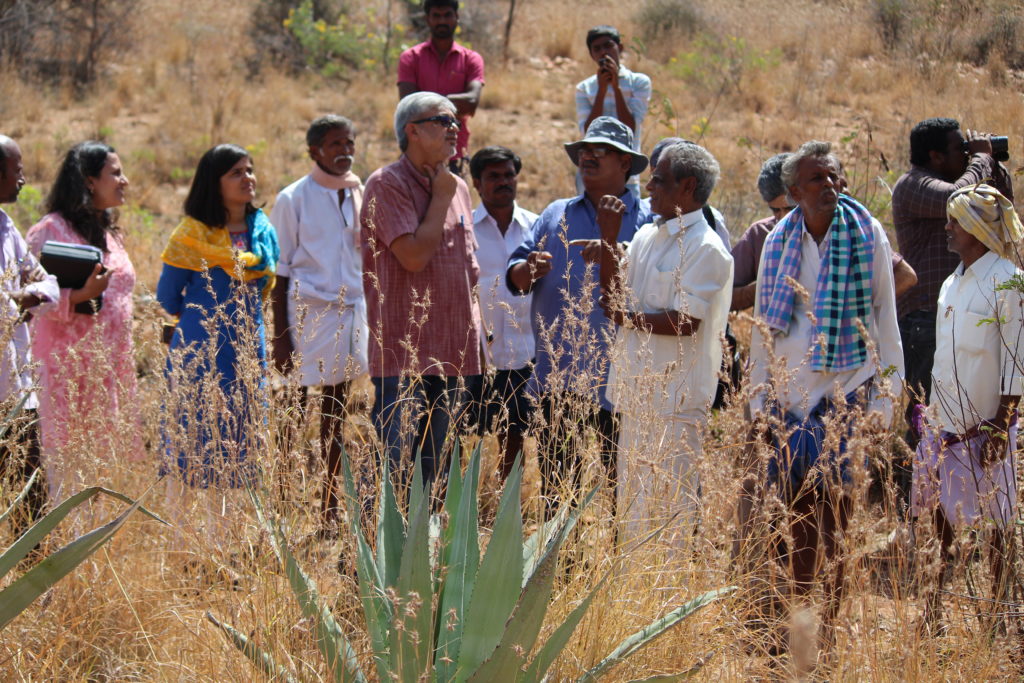
2. Importance of managing commons
Common property resources, such as water in a catchment, grazing lands or forests are different from private property, like a piece of agricultural land or a house. There is a distinction between private and common property resources within economics. The use of both these types of resources reduces their availability to others. For example, if one person uses 1000 litres of water or 1 acre of land, that much of these two resources are not available to others for use. This feature is called ‘divisible’ or ‘rival’ in economics literature.
However, it is not difficult to exclude people from using the resource in the case of private property, whereas this becomes very costly or requires greater effort in the case of commons. In order to ensure that no one cuts timber from a stretch of forest, there have to be efforts in the form of patrolling or rules/ bylaws or monitoring etc. This is true to ensure that one person does not take too much of groundwater or does not set fire on grazing land (which destroys all the fodder available there).
In certain cases, the intrinsic nature of the resource makes such an exclusion difficult. For example, determining the boundaries of groundwater is very difficult. In certain other cases, like grazing land, historically, these may have remained as non-private properties, and any person or persons may not have the incentive to see that their use by people does not lead to their destruction. Hence, common properties have the feature of non-excludability (of different degrees). These two properties – rival or divisible on the one hand, and non-excludability on the other hand – determine the nature of common property resources or commons.
3. `Tragedy of commons’ and the empirical counter-evidence
Given that these commons are rival or divisible, but non-excludable, encouraged commentators to predict that it would be very difficult to govern and manage or protect them and hence, there could be gradual and eventual destruction of these resources. Free-riding by a few people, and the disinterest of the rest in not controlling this, leading to the excessive use of these resources, is called the (possible) tragedy of commons.
Though the early commentators have predicted the possibility of the tragedy of commons, those researchers who have looked at the empirical experience of common property resources in different parts of the world have seen that communities have been managing these resources reasonably well. Elinor Ostrom, the political scientist, recipient of the Nobel Prize in Economics is known for her systematic documentation of the functioning of such community institutions. She and the researchers, who have associated with her, have documented cases where communities have managed water, forests and other such resources in different parts of the world (including poorer countries) to meet their short- and long-term needs. Such communities, which depend on common property resources for their survival, might have realized the importance of managing these resources and thereby, could devise appropriate self-governing institutions for this purpose.
4. Favourable conditions for community institutions
These empirical experiences and the later developments in economic theory (and the game theory) have encouraged economists to understand the functioning of community institutions deeply. They have moved away from modelling the exchange between two people within a community as a one-shot interaction (as in a prisoner’s dilemma game) and have started seeing these as (infinitely) repeated interactions. The theoretical developments, in this regard, have come up with these crucial insights:
- It is possible to sustain a cooperative equilibrium (or the one that encourages members to cooperate with the decision that enhances the collective welfare) through different kinds of strategies to punish the erring members in a situation where they interact repeatedly under two main conditions.
- The first condition is that the members perceive their interaction continuing for a very long duration. For example, this could be closer to the situation in a typical Indian village where different families have survived for generations.
- The second condition is that the participants of this community interaction should not `discount’ future gains heavily. To make this clear, we can take one example. If one of the members of the community is in a critical medical condition and for him/her, the future is highly uncertain, and survival in the current situation is much more important, and hence, he/she may take actions that are different from the ones which are agreed upon collectively. This is so, since, the strategies that may `punish’ her in future (say, not to interact with her in future) may not persuade her to cooperate, at present.
With the help of this framework, we can understand the management of commons and the role of FES, in the following sections.
5. Role of FES
The hydrological system of a geographical area or the land which is owned by different tiers of the government is part of the common properties or commons. The way the water resources in a catchment is managed would reflect in the availability of water during non-rainy periods, ground-water recharge, and also, floods. These can have a major impact on the livelihood of people in those areas where their main source of sustenance is rain-fed agriculture. The uncultivated land owned by one or the other tier of government may serve as grazing lands, and the availability of fodder in these lands is important for the cattle, livestock rearing – the other important source of livelihood for the people.
5.1 The situation before and the intervention of FES
Based on the discussions with the villagers in the habitations that we visited, the commons – whether these include locally available water resources or the uncultivated common land – were under the threat of depletion1 before the intervention of the FES. This is also evident from the photographs taken at different points of time of the common land. The traditional community institutions were not functioning well when FES started its intervention there. (We discuss the possible reasons for this state of affairs in a later section). There were mentions of possible migration due to the paucity of enough resources, locally. It is here that the FES has used its multi-pronged strategy to protect these common resources.
The primary focus of the organization’s work is the `ecological restoration and conservation of land and water resources, in the uplands and other eco-fragile, degraded and marginalized zones of the country’. It promotes protection and restoration of biological diversity through human efforts and governance and hence, works with democratic village institutions, their federal bodies, and civil society organizations.
5.2 Managing water resources
We visited a village, Tholapalle (Bagepalli), a small catchment where FES has helped people to manage locally available water resources on a sustainable basis. There is a tank at the foot of the hills, and this was constructed, originally, centuries ago by a local ruler. However, there have been various attempts to strengthen and repair it, and the FES has also provided financial resources initially for this purpose. We could see the work carried with the partial financial support of this organization.
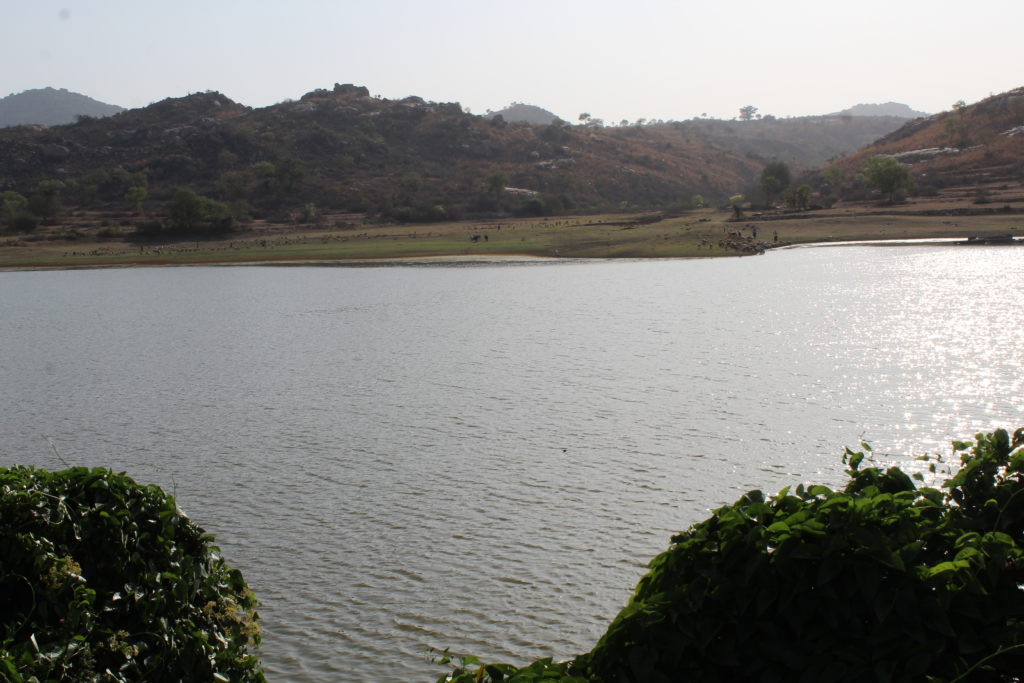
There is a local mechanism to distribute water. One person from a family has been assigned the role, traditionally, for this purpose. He is the reservoir operator, and this role is passed on to successive adult male members of the family. They would get a reward from each household of the village based on the size of the agricultural land it cultivates by using water from the tank. This return is in terms of the share of the produce that each household gets through the cultivation. The presence of such a person, socially sanctioned, seems to have helped in solving a number of coordination problems in the use and management of water. In places where such a traditional arrangement has been weakened, the FES has facilitated the strengthening of a management system to manage water usage from the tanks, as well as, extraction of groundwater through bore-wells. The FES organized a meeting of local people during our visit. There were 30-40 participants in that meeting. The organization seems to maintain a fairly good connection with the community.
What could be the specific contribution of the FES in the maintenance of sustainable water management in the locality? Our sense is that despite the existence of a water conservation system, its maintenance and management were not in a desirable condition when the organization started functioning there. This could be due to the lack of awareness and poverty and other vulnerabilities of the majority of people there preventing FES from mobilizing adequate resources and labour (or the time of local people) for maintenance. It is this trend of degeneration that can be checked by FES, through the creation of awareness and other interventions, and also, through the provision of limited financial assistance, leveraging government funds (like MGNREGA) and by working with different tiers of the government and community institutions. (There could be other enabling factors and that we discuss in a later section.) We have also seen the materials for the creation of awareness on the importance of conserving locally available water resources used by the organization there.
We had a short discussion on the difficulties, if any, in sustaining community action, currently. There could be a few members, who may not cooperate with the community, but others are in a position to persuade them to fall in line. Though many youngsters receive higher levels of education, and a few among them, take up jobs elsewhere, almost all households continue with agriculture or allied activities, and these too help the sustenance of community action for the conservation and sustainable use of water resources.
5.3 Managing uncultivated common land
We have also visited a village, Chennappagaripalle (Thambalapalle), where the FES has facilitated the growth and sustenance of trees and plants on the hill slopes – or the uncultivated land or the so-called wasteland with the help of the local community. This is attempted through `strengthening institutional mechanisms, evolving bylaws, rules and regulations for the use and conservation’. There are two hills – two sides or stretches of the same hill on both sides of the village – and the intervention of the FES is on the one side, whereas there is a government program for tree-plantation on the other. In other words, the former is community managed and the other is under the government. There is a clear difference in the status of biomass between these two parts, with the area planted by the government showing signs of poorer maintenance and low biomass density. There was also a discussion with the leaders and other members of the community. The close connection of the community with the FES was evident. In fact, one active member of the community has become a national-level member of the board of the organization, NTGCF (National Tree Growers Cooperative Federation Ltd.). There are also other active (including female) members of the community.
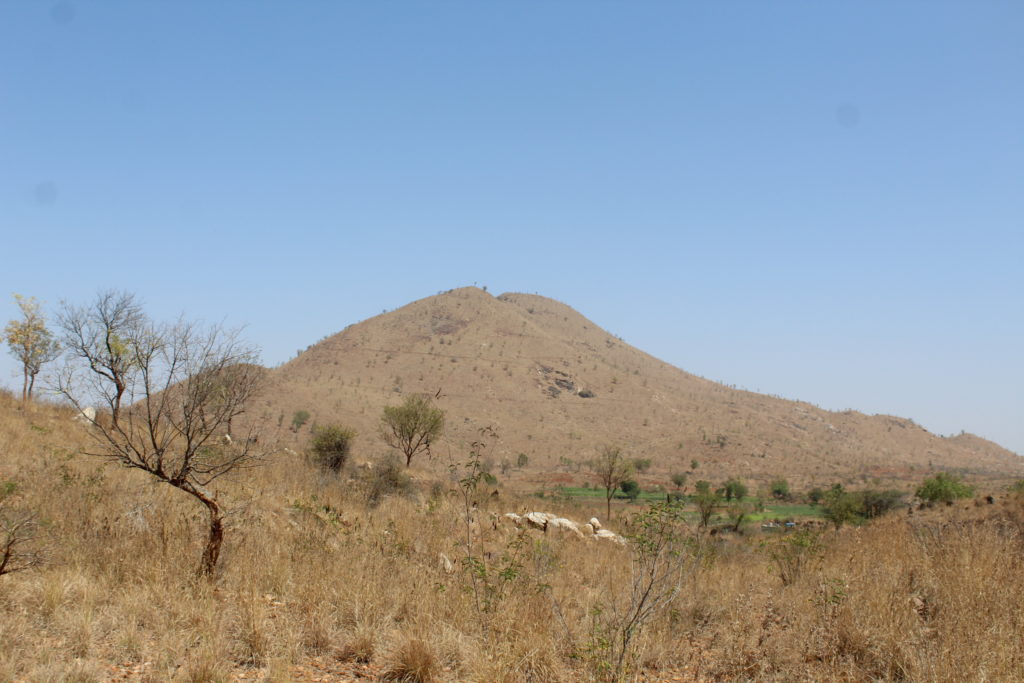
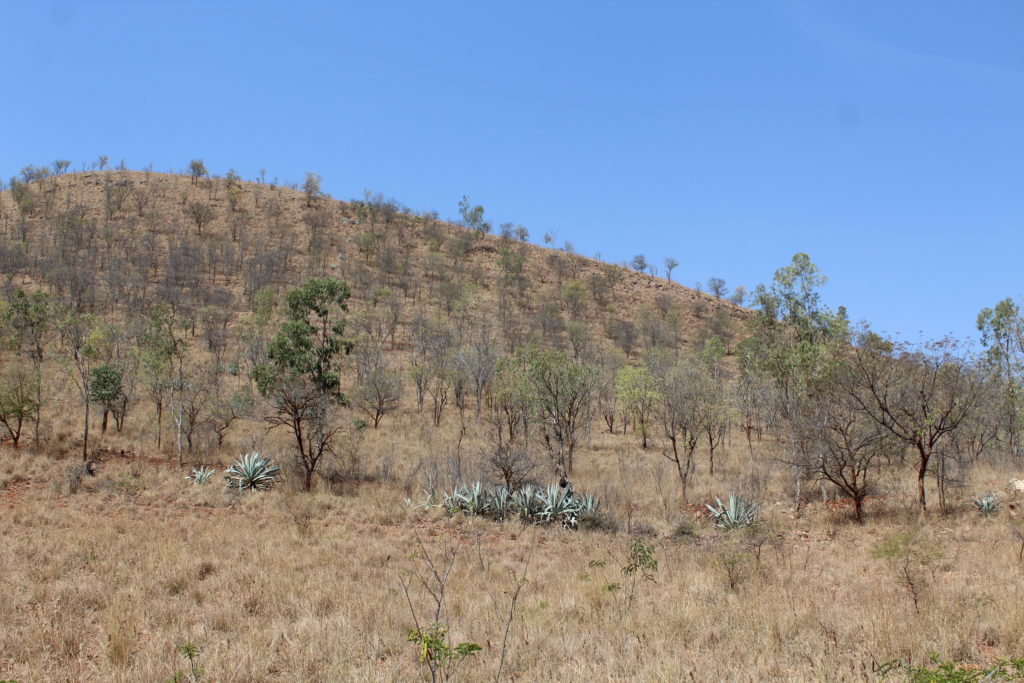
Our discussions revealed the following:
- This land or the biomass in that area was witnessing degradation before the intervention of FES
- A crucial interest for the local people to sustain the biomass is the need for fodder for cattle (mainly sheep), and animal husbandry is an important livelihood activity. Those people who have cattle or livestock, lose significantly if there is not enough fodder.
- Though local people have been using the biomass for cooking, this dependence has come down recently due to the spread of LPG as cooking fuel through the government program.
- Forest fires occur frequently, and this could be due to some unintended human action (drying of the local grass facilitates the spread of fire). The community and FES are yet to come up with an effective strategy to reduce the frequent occurrence of such fires.
Local community perceives correctly that the protection of biomass on the hill slopes has enhanced the water retention and recharge, and it improves the availability of water in the local stream and other water bodies in non-rainy periods, which in turn supports, their cultivation. These messages are getting incorporated into the local efforts of environmental education of school children.
We tried to explore the persistence of internal conflicts, if any, in the management of commons. The locality or the access to the hill slope is such that it would be very difficult for any external person to come there to cut down trees. Local people continue to have reasonably close relationships between themselves and that is facilitating them to exert informal pressure on each other so that everybody follows collective decisions. Though FES has provided certain financial assistance during the initial years of their intervention in the village, it is no longer providing such assistance. However, the collective action facilitated by FES continues there.
Approach and strategy of FES
The FES identifies a community/village which has a minimum of 10 hectares of common land which the village depends on for their everyday needs. The identification process is followed by long-term intervention. The FES team starts building rapport with the community through individual interactions and community meetings. Usually, the PRI members /Sarpanch are the first persons they interact with, and with their help, community mobilization is initiated. Multiple meeting, frequent house visits and exposure to the work of FES in other villages make a positive impact.
The village members are brought together to form a committee where all members, above 18 years of age, are included. The village committee meetings are facilitated and multiple sensitization, as well as, capacity building exercises are conducted. The village committee forms guidelines for protection, management, use and nurturing of commons, with do’s and don’ts, details of the monitoring process, penalties on misuse or causing a threat to the commons, etc. Though the community is cohesive, conflicts do arise in some situations, which are discussed, and appropriate actions are taken by the village committee. According to the organization, secure tenure, collective action and restoration, together can make a difference and these are the three cornerstones which form the core work of the organization. The community getting rights to manage the common land is one of the first steps that builds ownership and enables further investments and long-term management by the community.
The overall approach of the FES includes the following:
- It uses scientific and technical knowledge for the protection of commons.
- Though their concern is ecological conservation, this is carried out by enabling the livelihood of people who depend on such resources. Eco-restoration is carried out by enabling local community-level institutions to manage and protect their commons, ultimately leading to sustained livelihoods. This is based on a social-ecological system view that sees conservation and livelihoods together.
- Collective action of people plays an important role in the whole process.
- The organization plays an important role to facilitate and sustain that collective action.
7. Impacts noted by FES
It is important to note that the FES has put in place mechanisms not only for the effective implementation of projects but also for the monitoring and evaluation of the projects. They do carry out baseline assessments of the situation2 and the impacts. The economic benefits of the conservation and sustainable management of commons are also assessed3.
For example, the organization has assessed the impacts and social returns of a program that has aimed at strengthening the sustainable use of water commons in about 800 habitations in five states (Karnataka, Andhra Pradesh, Rajasthan, Madhya Pradesh, and Maharashtra). The interventions of FES, in this regard, are the following: `(a) Creating a common understanding of water, particularly groundwater as a shared resource. (b) Formalizing local rules and norms for collective management of land and water resources. (c) Securing collective tenurial rights over land and water resources through various arrangements with government (d) Using tools and technology to enable more informed planning and decision making (e) Channelizing MGNREGA for land and water rejuvenation and aligning the rights to employment with the right to resources (f) Supporting farmers in adoption of low external input and water-saving practices and increasing their crop productivity’.
Towards the end of the fourth year, the FES has achieved the following milestones (based on its impact assessment): ` (a) Rules and regulations for collaborative management of land and water resources established by the local communities over 33,539 ha of common land and 1,346 water bodies (b) 11,217 ha of degraded land treated (c) 37,969 TCM water harvested due to various soil and moisture conservation initiatives and 10,023 TCM water saved due to improved agricultural practices (d) INR 708.97 lakh of MGNREGA investment channelized for rejuvenation of land and water resources and systems established for maintenance of these assets by the local communities in the long run’.
There have also been documentation of the community perceptions on different aspects such as `high to very high improvement in the participation of people in planning and decision making’ and `formalization of rules and regulations for water conservation and usage, and increasing practice of sharing of wells or bore-wells’ over years, and this has enhanced the `trust and confidence amongst the beneficiaries to talk and negotiate with Panchayat/Block and other external actors’. Or observations, such as `nearly 75% of the farmers surveyed during the assessment shared that there has been an improvement in the soil and moisture regime in their agricultural lands subsequent to the interventions,’ have been documented.
The purpose of this report is not to assess the impact or to validate the assessments already carried out by FES. However, we have identified certain knowledge gaps in the functioning of the organization, and these are mentioned in the last section.
8. Enabling conditions
There seem to be certain enabling conditions for the relative effectiveness of the interventions of FES. The localities that they have selected (or the ones that we have visited) are the ones where people continue to have a strong interest in protecting common properties, such as water or uncultivated lands. First, most of the population in the area or the selected villages continue to be involved in agriculture. Jobs in industry or services have not taken many people away from these localities. These are also drier areas with limited rainfall. The preservation and careful use of a limited, available water resource is important for the continuation of cultivation there. Another important source of livelihood is cattle rearing (small ruminants, like sheep or goats). The fodder for these animals is met from the non-private and uncultivated lands. That would give them an incentive to sustain biomass in these lands. Forest fires which lead to the destruction of this biomass can affect their livelihood and hence, they have an incentive to take collective action to prevent forest fire (but that has not been very successful).
Though there is seasonal migration of people from these localities, there is not much permanent immigration to or out-migration from these localities. Hence, there is a persistence of a certain level of mutual dependence among the people there. All these may serve as enabling factors for the involvement of people in the management of common properties.
However, this is not to argue that the people in these communities would have taken steps to conserve and manage commons even without the intervention of an external agency, like FES. This is evident from the fact that there was a certain disarray in the management and hence, there was a degradation of these properties before the intervention of FES in these localities. We may not be able to trace the exact reasons for the inadequate success of the collective action (especially, when we consider the prevalence of enabling conditions that we have discussed here) before the intervention of an external agency. There could be some other factors that might have discouraged them from taking collective actions to protect common properties adequately. Rights to these resources could be an important issue, especially, when communities do not have secure rights in, what is seen as, state property. There could be a certain lack of information on the need to protect these resources. Given the poverty and vulnerability of a substantial share of people in such localities in India, they may be concerned about other pressing needs and that may lead to the neglect of certain common property resources. (This could be equivalent to the use of higher discount rates as discussed in economics literature). It could be the case that people may not, by themselves, take certain actions which are beneficial to them and that may require `nudging’ by others (an insight from behavioural economics).
9. What may happen in future?
The sustainability of the community management of resources in future, in these areas, may depend on a number of factors. The possible trends in this regard can be noted from what is already happening there. For example, the enhanced use of LPG as a cooking fuel has reduced the dependence of local people on fuelwood, and on uncultivated common lands for this purpose. This is beneficial in the sense that they will not use common land for this purpose. However, such a reduced dependence can also reduce the incentive to take care of common properties. This may be true for a number of other livelihood activities. Currently, the grazing by sheep (or goats) and the consequent requirement for fodder is an important need for people, encouraging them to use uncultivated common land on a sustainable basis. There can be a change in this need. The reduction in the use of water in agriculture or the availability of other sources (such as canal water from a distant source) can also lead to the disuse or the lack of interest on the part of the community in the proper maintenance of local water resources. However, such a change need not happen if the commons are seen not only for their commodity- or use-value but also for its social-cultural values. Even with changing nature and extents of dependence on commons (for its economic benefit), these are known to be an important part of the social-cultural ethos of many of these communities and are acknowledged for their ecological importance.
All these possible changes may be considered while thinking about the possible institutional structure and interventions required for the conservation of common property resources.
10. Knowledge gaps
As noted earlier, FES has attempted to document the impact of its intervention. However, the processes of intervention in multiple locations, the challenges faced in each, the kind of strategies used by the organization or its employees to overcome these challenges, and the failures and successes, in this regard, are not documented adequately. There is an implicit or tacit knowledge on these aspects in the employees of the organization. For example, in our conversation, one of them has noted such a case—the not-so-enthusiastic attitude of a local community to the campaign materials prepared in the state language, and their enhanced enthusiasm when these materials are made available in the language of the community. In another case, they mentioned the strategies used by the community to discipline or punish the non-cooperating members – different types of community estrangement which would encourage such non-co-operators to fall in line with the majority decisions of the community.
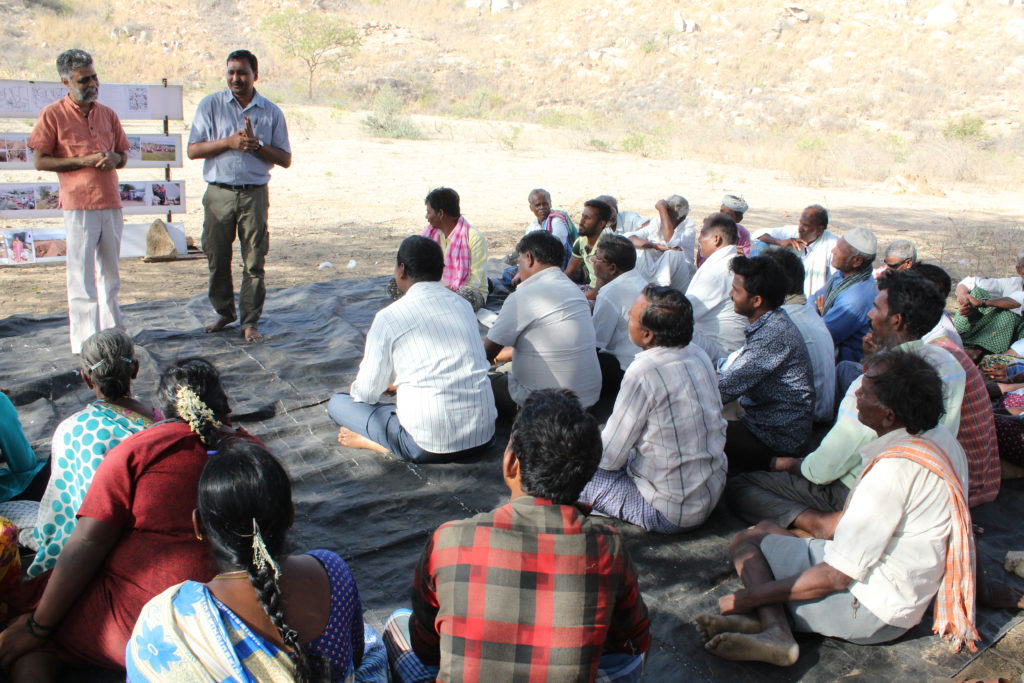
The successes and failures in the management of commons may depend not only on the features of specific people (for example, the leader of a community or an employee of the NGO who is dealing with specific communities) but also the `objective’ conditions of specific localities. These may include the homogeneity/heterogeneity within the community, the livelihood activities, the dependence of local people on wider markets, and so on. The variations in this regard between different localities may be used to understand the determinants of the successes and failures. It would be great if the FES can come out with these assessments, which would be very useful for others who want to learn from their experience.
One approach to this could be to encourage field-level employees of FES to write reflective documentation of their practice in specific localities. They may be exposed to similar documentation so that they can be forthright in expressing their challenges, failures, frustrations along with their successes and achievements. There could be multiple issues that they have confronted in dealing with communities, and some of these could be sorted out due to their own or someone else’s actions (and some other issues may remain unresolved.) Reflective documentation of all these and making these available in the public domain could be useful for other organizations (or for budding development practitioners) planning to enter the management of commons. It can also be useful for researchers who want to generalize based on the experience of specific cases. Moreover, it would contribute to new knowledge on how to make the management of commons work by navigating through the challenges encountered in specific contexts.
AUTHORS
V Santhakumar, Professor, Azim Premji University
Anant Gangola, Associate Director, Field Practice and Students Affairs, Azim Premji University
Subrat Mishra, Program Manager, Field Practice and Students Affairs, Azim Premji University

